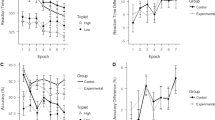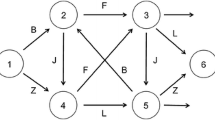Abstract
We report two experiments using the artificial-grammar task that demonstrate order dependence in implicit learning. Studying grammatical training strings in different orders did not affect participants’ discrimination of grammatical from ungrammatical test strings, but it did affect their judgments about specific test strings. Current accounts of learning in the artificial-grammar task focus on category-level discrimination and largely ignore item-level discrimination. Hence, the results highlight the importance of moving theory from a category- to an item-level of analysis and point to a new way to evaluate and to refine accounts of implicit learning.




Similar content being viewed by others
References
Brooks, L. R. (1978). Nonanalytic concept formation and memory for instances. In E. Rosch & B. B. Lloyd (Eds.), Cognition and categorization (pp. 170–211). Hillsdale: Erlbaum.
Brooks, L. R., & Vokey, J. (1991). Abstract analogies and abstracted grammars: comments on Reber (1989) and Mathews et al. (1989). Journal of Experimental Psychology General, 120, 316–323.
Chubala, C. M., & Jamieson, R. K. (2013). Recoding and representation in artificial grammar learning. Behavior Research Methods, 45, 470–479.
Dienes, Z. (1992). Connectionist and memory-array models of artificial grammar learning. Cognitive Science, 16, 41–79.
Dulany, D. E., Carlson, R. A., & Dewey, G. I. (1984). A case of syntactical learning and judgement: how conscious and how abstract? Journal of Experimental Psychology General, 113, 541–555.
Dunn, J. C. (2008). The dimensionality of the remember-know task: a state-trace analysis. Psychological Review, 2008(115), 426–446.
Dunn, J. C., & Kirsner, K. (1988). Discovering functionally independent mental processes: the principle of reversed association. Psychological Review, 95, 91–101.
Dunn, J. C., & Kirsner, K. (2003). What can we infer from double dissociations? Cortex, 39, 1–7.
Herbranson, W. T., & Shimp, C. P. (2008). Artificial grammar learning in pigeons. Learning and Behavior, 36, 116–137.
Higham, P. A., & Vokey, J. R. (1994). Recourse to stored exemplars is not necessarily explicit: a comment on Knowlton, Ramus, and Squire (1992). Psychological Science, 5, 59–60.
Jamieson, R. K., Crump, M. J. C., & Hannah, S. D. (2012). An instance theory of associative learning. Learning and Behavior, 40, 61–82.
Jamieson, R. K., & Hauri, B. R. (2012). An exemplar model of performance in the artificial grammar task: holographic representation. Canadian Journal of Experimental Psychology, 66, 98–105.
Jamieson, R. K., Holmes, S., & Mewhort, D. J. K. (2010). Global similarity predicts dissociation of classification and recognition: evidence questioning the implicit-explicit learning distinction in amnesia. Journal of Experimental Psychology Learning Memory and Cognition, 36, 1529–1535.
Jamieson, R. K., & Mewhort, D. J. K. (2009). Applying an exemplar model to the artificial-grammar task: inferring grammaticality from similarity. Quarterly Journal of Experimental Psychology, 62, 550–575.
Jamieson, R. K., & Mewhort, D. J. K. (2010). Applying an exemplar model to the artificial-grammar task: string-completion and performance on individual items. Quarterly Journal of Experimental Psychology, 63, 1014–1039.
Jamieson, R. K., & Mewhort, D. J. K. (2011). Grammaticality is inferred from global similarity: a reply to Kinder (2010). Quarterly Journal of Experimental Psychology, 64, 209–216.
Jamieson, R. K., Nevzorova, U., Lee, G., & Mewhort, D. J. K. (2015). Information theory and artificial grammar learning: Inferring grammaticality from redundancy. Psyc hological Research. [Epub ahead of print]
Johns, E. E., & Mewhort, D. J. K. (2002). What information underlies correct rejections in recognition from episodic memory? Memory and Cognition, 30, 46–59.
Johns, E. E., & Mewhort, D. J. K. (2003). The effect of feature frequency on short-term recognition memory. Memory and Cognition, 31, 285–296.
Johns, E. E., & Mewhort, D. J. K. (2009). Test sequence priming in recognition memory. Journal of Experimental Psychology Learning Memory and Cognition, 35, 1162–1174.
Johns, E. E., & Mewhort, D. J. K. (2011). Serial-position effects for lures in short-term recognition memory. Psychonomic Bulletin and Review, 18, 1126–1132.
Johnstone, T., & Shanks, D. R. (2001). Abstractionist and processing accounts of implicit learning. Cognitive Psychology, 42, 61–112.
Kamin, L. J. (1969). Predictability, surprise, attention and conditioning. In B. A. Campbell & R. M. Church (Eds.), Punishment and aversive behavior (pp. 279–296). New York: Appleton-Century-Crofts.
Kinder, A. (2010). Is grammaticality inferred from global similarity? Comment on Jamieson and Mewhort (2009). Quarterly Journal of Experimental Psychology, 63, 1049–1056.
Kinder, A., & Shanks, D. R. (2001). Amnesia and the declarative/nondeclarative distinction: a recurrent network model of classification, recognition, and repetition priming. Journal of Cognitive Neuroscience, 15, 648–669.
Kinder, A., & Shanks, D. R. (2003). Neuropsychological dissociations between priming and recognition: a single-system connectionist account. Psychological Review, 110, 728–744.
Knowlton, B. J., Ramus, S. J., & Squire, L. R. (1992). Intact artificial grammar learning in amnesia: dissociation of classification learning and explicit memory for specific instances. Psychological Science, 3, 172–179.
Lotz, A., & Kinder, A. (2006). Transfer in artificial grammar learning: the role of repetition information. Journal of Experimental Psychology Learning Memory and Cognition, 32, 707–715.
Manza, L., & Reber, A. S. (1997). Representing artificial grammars: transfer across stimulus forms and modalities. In D. C. Berry (Ed.), How implicit is implicit learning? (pp. 73–106). Oxford: Oxford University Press.
Mewhort, D. J. K., & Johns, E. E. (2000). The extralist-feature effect: a test of item matching in short-term recognition memory. Journal of Experimental Psychology: General, 129, 262–284.
Mewhort, D. J. K., & Johns, E. E. (2005). Sharpening the echo: an iterative-resonance model for short-term recognition memory. Memory, 13, 300–307.
Miller, G. A. (1958). Free recall of redundant strings of letters. Journal of Experimental Psychology, 56, 433–491.
Miller, R. R. (2006). Challenges facing contemporary associative approaches to acquired behavior. Comparative Cognition and Behavior Reviews, 1, 77–93.
Nosofsky, R. M. (1986). Attention, similarity, and the identification-categorization relationship. Journal of Experimental Psychology General, 115, 39–57.
Nosofsky, R. M., & Zaki, S. R. (1998). Dissociations between categorization and recognition in amnesic and normal individuals: an exemplar-based interpretation. Psychological Science, 9, 247–255.
Perruchet, P., & Pacteau, C. (1990). Synthetic grammar learning: implicit rule abstraction or explicit fragmentary knowledge? Journal of Experimental Psychology General, 119, 264–275.
Perruchet, P., & Vinter, A. (1998). PARSER: a model for word segmentation. Journal of Memory and Language, 39, 246–263.
Poletiek, F. H., & Lai, J. (2012). How semantic biases in simple adjacencies affect learning a complex structure with non-adjacencies in AGL: a statistical account. Philosophical Transactions of the Royal Society, 367, 2046–2054.
Poletiek, F. H., & van Schijndel, T. J. P. (2009). Stimulus set size and grammar coverage in artificial grammar learning. Psychonomic Bulletin and Review, 16, 1058–1064.
Pothos, E. M. (2005). The rules versus similarity distinction. Behavioral and Brain Science, 28, 1–49.
Pothos, E. M., & Bailey, T. M. (2000). The importance of similarity in artificial grammar learning. Journal of Experimental Psychology Learning Memory and Cognition, 26, 847–862.
Ratcliff, R. (1990). Connectionist models of recognition memory: constraints imposed by learning and forgetting functions. Psychological Review, 97, 285–308.
Reber, A. S. (1967). Implicit learning of artificial grammars. Journal of Verbal Learning and Verbal Behaviour, 5, 855–863.
Reber, A. S. (1969). Transfer of syntactic structure in synthetic languages. Journal of Experimental Psychology, 81, 115–119.
Reber, P. J. (2002). Attempting to model dissociations of memory. Trends in Cognitive Sciences, 6, 192–194.
Reber, A. S., Kassin, S. M., Lewis, S., & Cantor, G. (1980). On the relationship between implicit and explicit modes in the learning of a complex rule structure. Journal of Experimental Psychology Human Learning and Memory, 6, 492–502.
Reber, R., & Perruchet, P. (2003). The use of control groups in artificial grammar learning. The Quarterly Journal of Experimental Psychology, 56, 97–113.
Redington, M., & Chater, N. (1996). Transfer in artificial grammar learning: a reevaluation. Journal of Experimental Psychology General, 125, 123–138.
Rotello, C. M., Macmillan, N. A., & Van Tassel, G. (2000). Recall-to-reject in recognition memory: evidence from ROC curves. Journal of Memory and Language, 43, 67–88.
Schiff, R., & Katan, P. (2014). Does complexity matter? Meta analysis of learner performance in artificial grammar tasks. Frontiers in Psychology, 5, 1084.
Servan-Schreiber, E., & Anderson, J. R. (1990). Learning artificial grammars with competitive chunking. Journal of Experimental Psychology Learning Memory and Cognition, 16, 592–608.
Shanks, D. R. (1985). Forward and backward blocking in human contingency judgement. The Quarterly Journal of Experimental Psychology, 37, 1–21.
Shanks, D. R. (2010). Learning: from association to cognition. Annual Review of Psychology, 61, 273–301.
Shanks, D. R., & St. John, M. F. (1994). Characteristics of dissociable human learning systems. Behavioral and Brain Sciences, 17, 367–395.
Tunney, R. J., & Altmann, G. T. M. (1999). The transfer effect in artificial grammar learning: reappraising the evidence of transfer of sequential dependencies. Journal of Experimental Psychology Learning Memory and Cognition, 25, 1322–1333.
van den Bos, E., & Poletiek, F. H. (2008). Intentional artificial grammar learning: when does it work? European Journal of Cognitive Psychology, 4, 793–806.
Van Orden, G. C., & Kloos, H. (2003). The module mistake. Cortex, 39, 164–166.
Van Orden, G. C., Pennington, B. F., & Stone, G. O. (2001). What do double dissociations prove? Cognitive Science, 25, 111–172.
Vokey, J. R., & Brooks, L. R. (1992). Salience of item knowledge in learning artificial grammars. Journal of Experimental Psychology Learning Memory and Cognition, 18, 328–344.
Vokey, J. R., & Higham, P. A. (1999). Implicit knowledge as automatic, latent knowledge. Behavioral and Brain Sciences, 22, 787–788.
Vokey, J. R., & Higham, P. A. (2004). Opposition logic and neural network models in artificial grammar learning. Consciousness and Cognition, 13, 565–578.
Vokey, J. R., & Higham, P. A. (2005). Abstract analogies and positive transfer in artificial grammar learning. Canadian Journal of Experimental Psychology, 59, 54–61.
Vokey, J. R., & Jamieson, R. K. (2014). A visual familiarity account of evidence for orthographic processing in baboons (Papio papio). Psychological Science, 25, 991–996.
Whittlesea, B. W., & Wright, R. L. (1997). Implicit (and explicit) learning: acting adaptively without knowing the consequences. Journal of Experimental Psychology Learning Memory and Cognition, 23, 181–200.
Zaki, S. R., & Nosofsky, R. M. (2001). A single-system interpretation of dissociations between recognition and categorization in a task involving object-like stimuli. Cognitive, Affective, & Behavioral Neuroscience, 1, 344–359.
Acknowledgments
This research was supported by grants from the Natural Sciences and Engineering Research Council of Canada to all three authors. We thank Steve Lindsay for advice on the statistical analysis.
Author information
Authors and Affiliations
Corresponding author
Rights and permissions
About this article
Cite this article
Jamieson, R.K., Vokey, J.R. & Mewhort, D.J.K. Implicit learning is order dependent. Psychological Research 81, 204–218 (2017). https://doi.org/10.1007/s00426-015-0715-4
Received:
Accepted:
Published:
Issue Date:
DOI: https://doi.org/10.1007/s00426-015-0715-4




